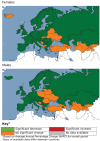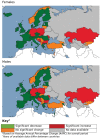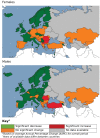Epidemiology report: trends in sex-specific cerebrovascular disease mortality in Europe based on WHO mortality data
- PMID: 30124820
- PMCID: PMC6396027
- DOI: 10.1093/eurheartj/ehy378
Epidemiology report: trends in sex-specific cerebrovascular disease mortality in Europe based on WHO mortality data
Abstract
Aims: There have been substantial declines in cerebrovascular disease mortality across much of Europe, mirroring trends in deaths from cardiovascular disease as a whole. No study has investigated trends in cerebrovascular disease, and its subtypes within all European countries. This study aimed to examine sex-specific trends in cerebrovascular disease, and three of its sub-types: ischaemic stroke, haemorrhagic stroke, and subarachnoid haemorrhage (SAH), in Europe between 1980 and 2016.
Methods and results: Sex-specific mortality data for each country of the World Health Organization (WHO) Europe region were extracted from the WHO global mortality database and analysed using Joinpoint software to examine trends. The number and location of significant joinpoints for each country by sex and subtype was determined using a log-linear model. The annual percentage change within each segment was calculated along with the average annual percentage change over the duration of all available data. The last 35 years have seen large overall declines in cerebrovascular disease mortality rates in the majority of European countries. While these declines have continued steadily in more than half of countries, this analysis has revealed evidence of recent plateauing and even increases in stroke mortality in a number of countries, in both sexes, and in all four geographical sub-regions of Europe. Analysis by stroke sub-type revealed that recent plateauing was most common for haemorraghic stroke and increases were most common for ischaemic stroke.
Conclusion: These findings highlight the need for continued research into the inequalities in both current stroke mortality outcomes and trends across Europe, as well as the causes behind any recent plateauing of total cerebrovascular disease or its subtypes.
Keywords: Cerebrovascular disease; Europe; Joinpoint regression analysis; Mortality; Stroke; Trends.
© The Author(s) 2018. Published by Oxford University Press on behalf of the European Society of Cardiology.
Figures





Comment in
-
Death from stroke in Europe: if you can't measure it, you can't improve it.Eur Heart J. 2019 Mar 1;40(9):765-767. doi: 10.1093/eurheartj/ehy543. Eur Heart J. 2019. PMID: 30239662
References
-
- Wilkins E, Wilson L, Wickramasinghe K, Bhatnagar P, Leal J, Luengo-Fernandez R, Burns R, Rayner M, Townsend N.. European Cardiovascular Disease Statistics 2017. Brussels: European Heart Network; 2017.
-
- Timmis A, Townsend N, Gale C, Grobbee R, Maniadakis N, Flather M, Wilkins E, Wright L, Vos R, Bax J, Blum M, Pinto F, Vardas P.. European Society of Cardiology: cardiovascular disease statistics 2017. Eur Heart J 2018;39:508–579. - PubMed
Publication types
MeSH terms
LinkOut - more resources
Full Text Sources
Other Literature Sources

